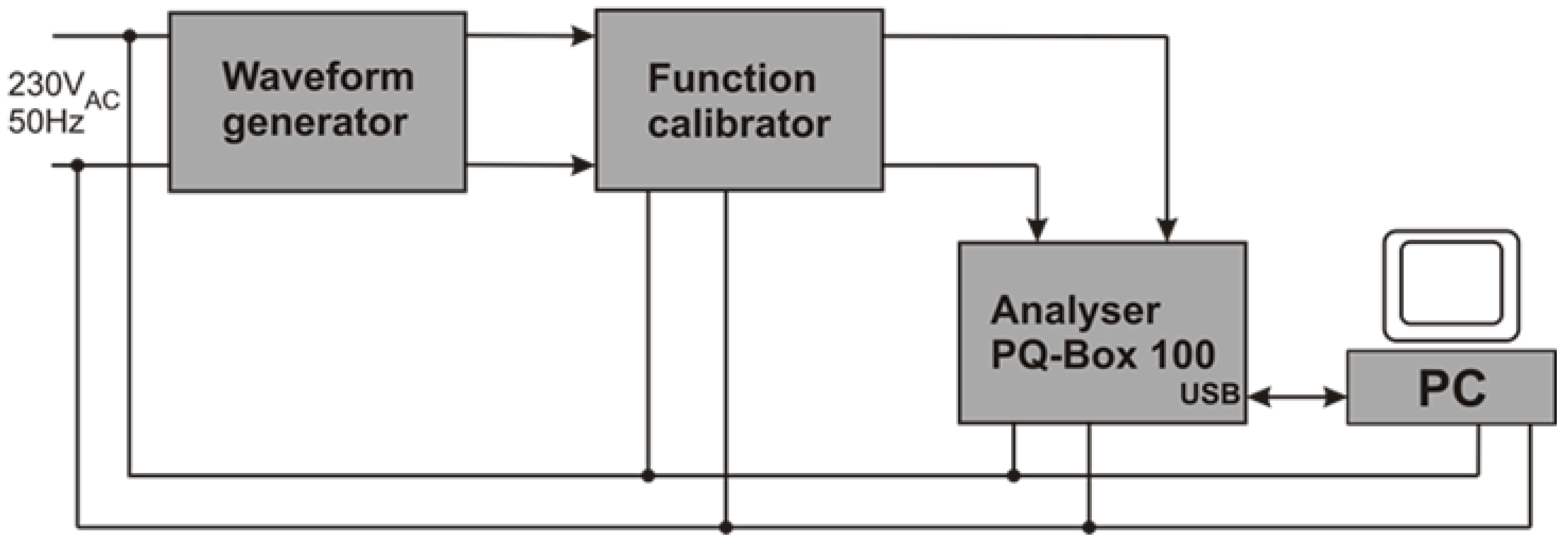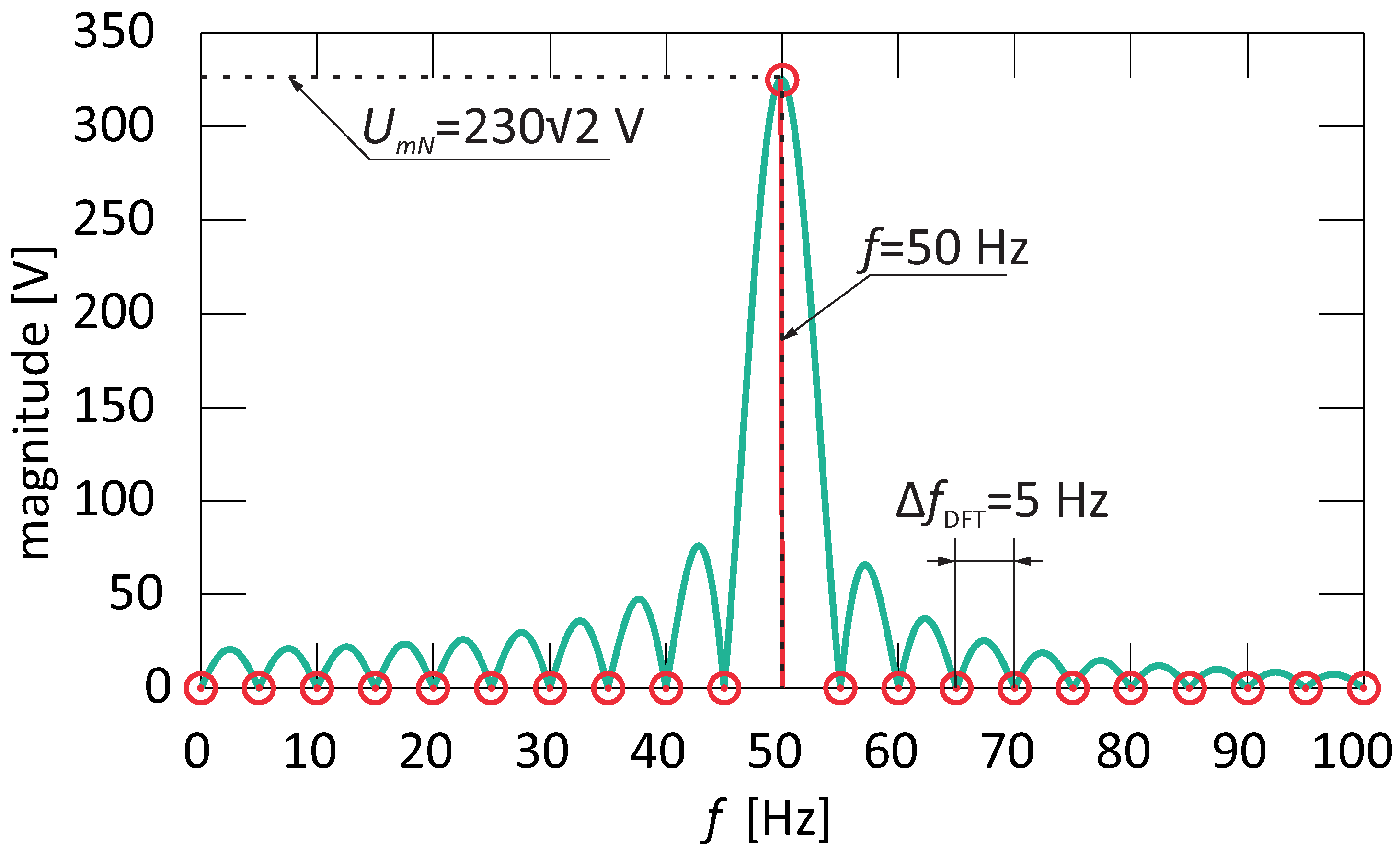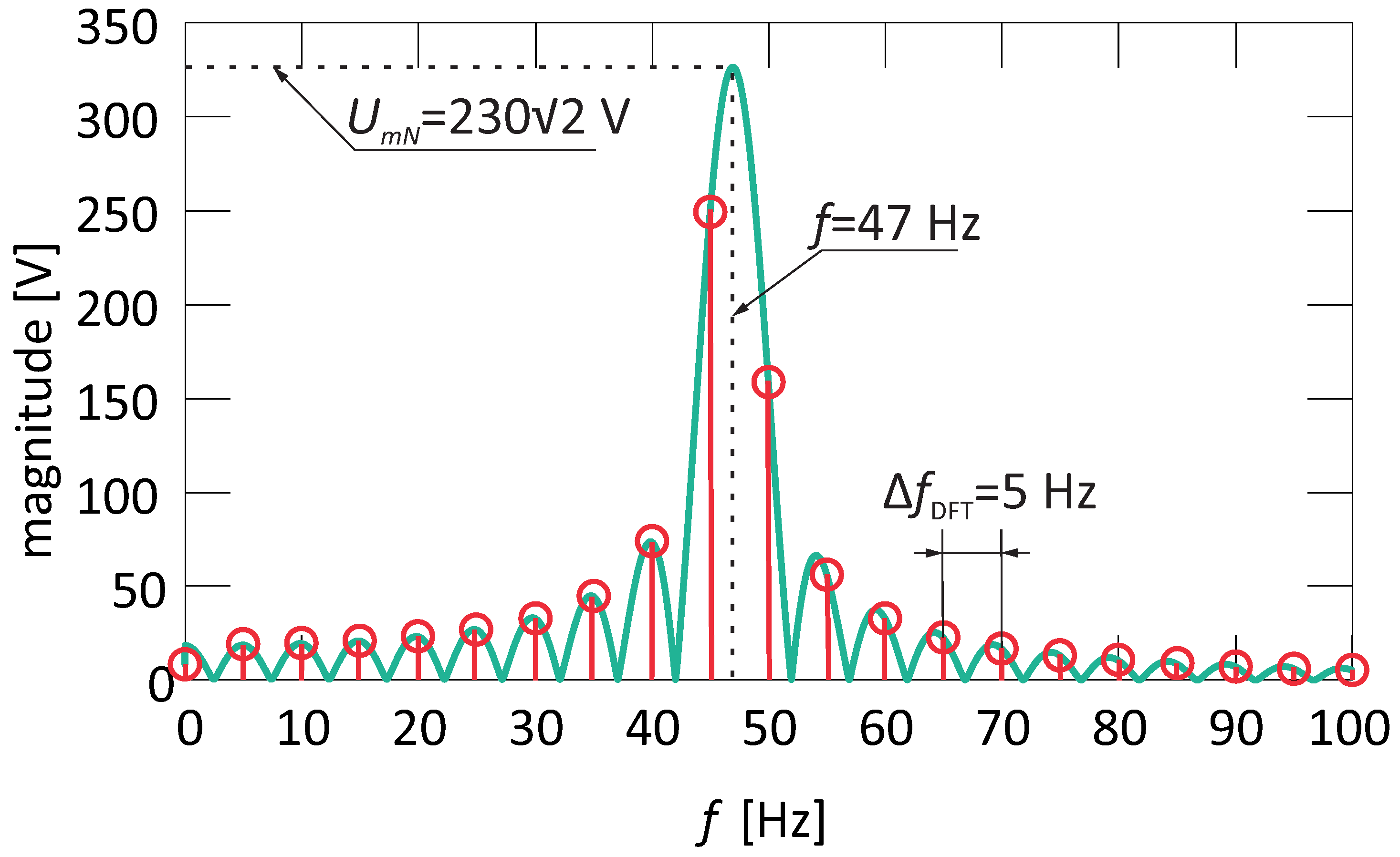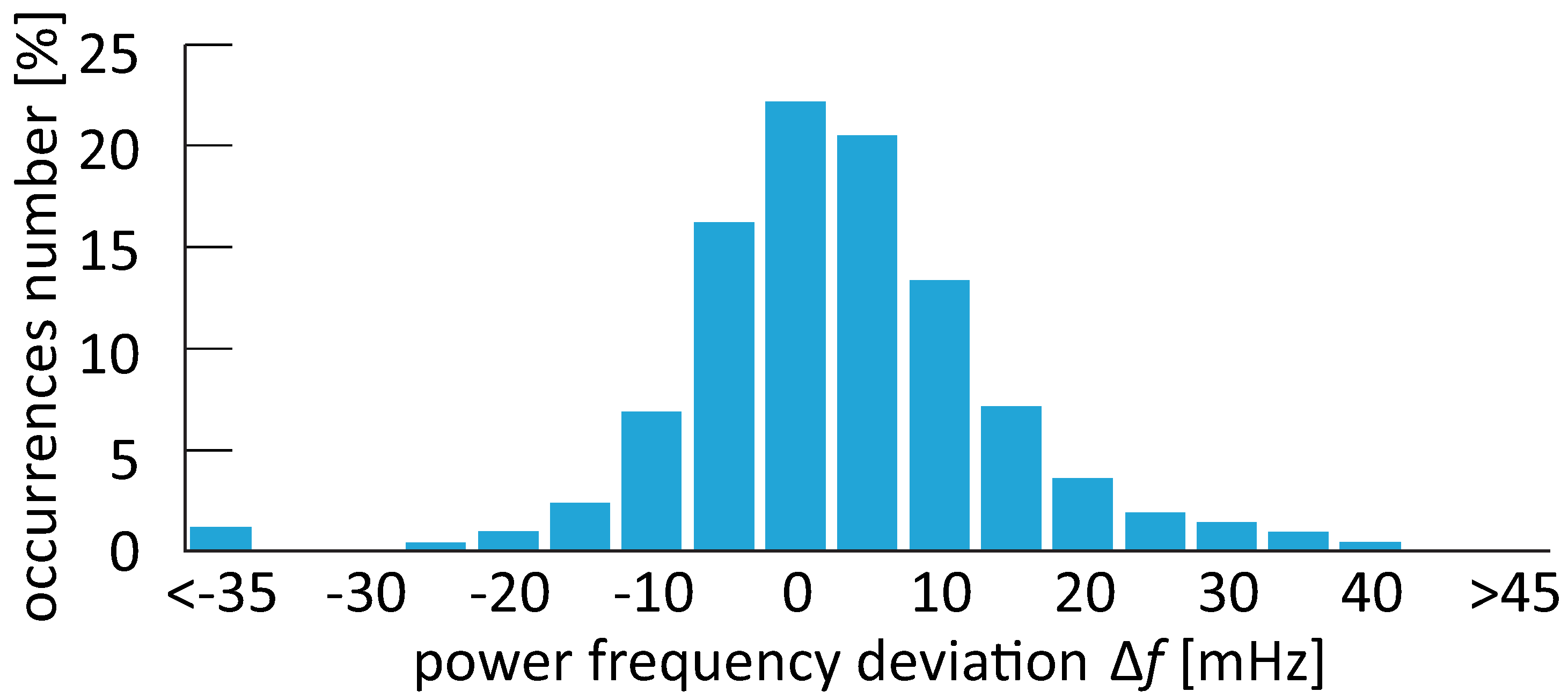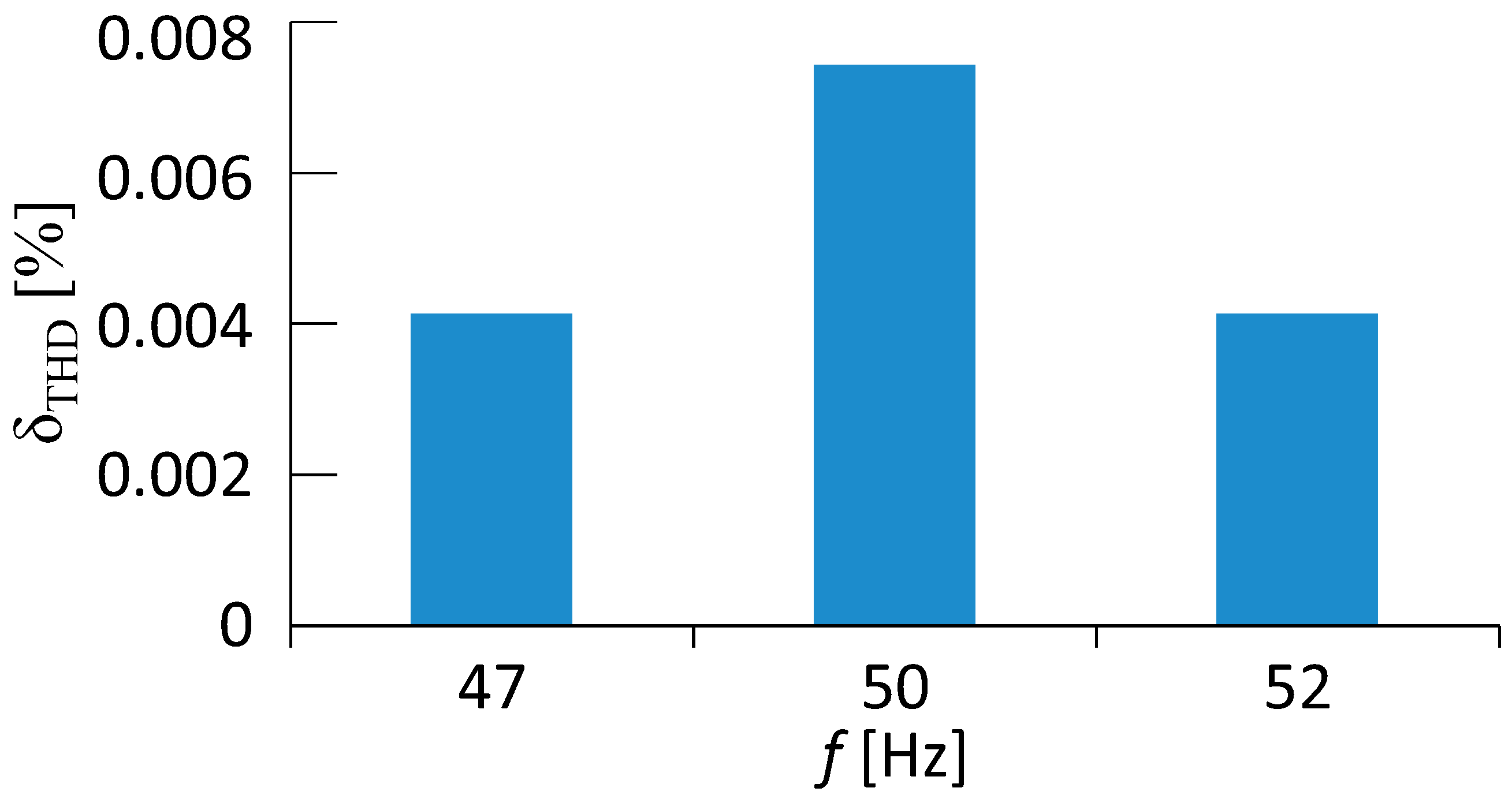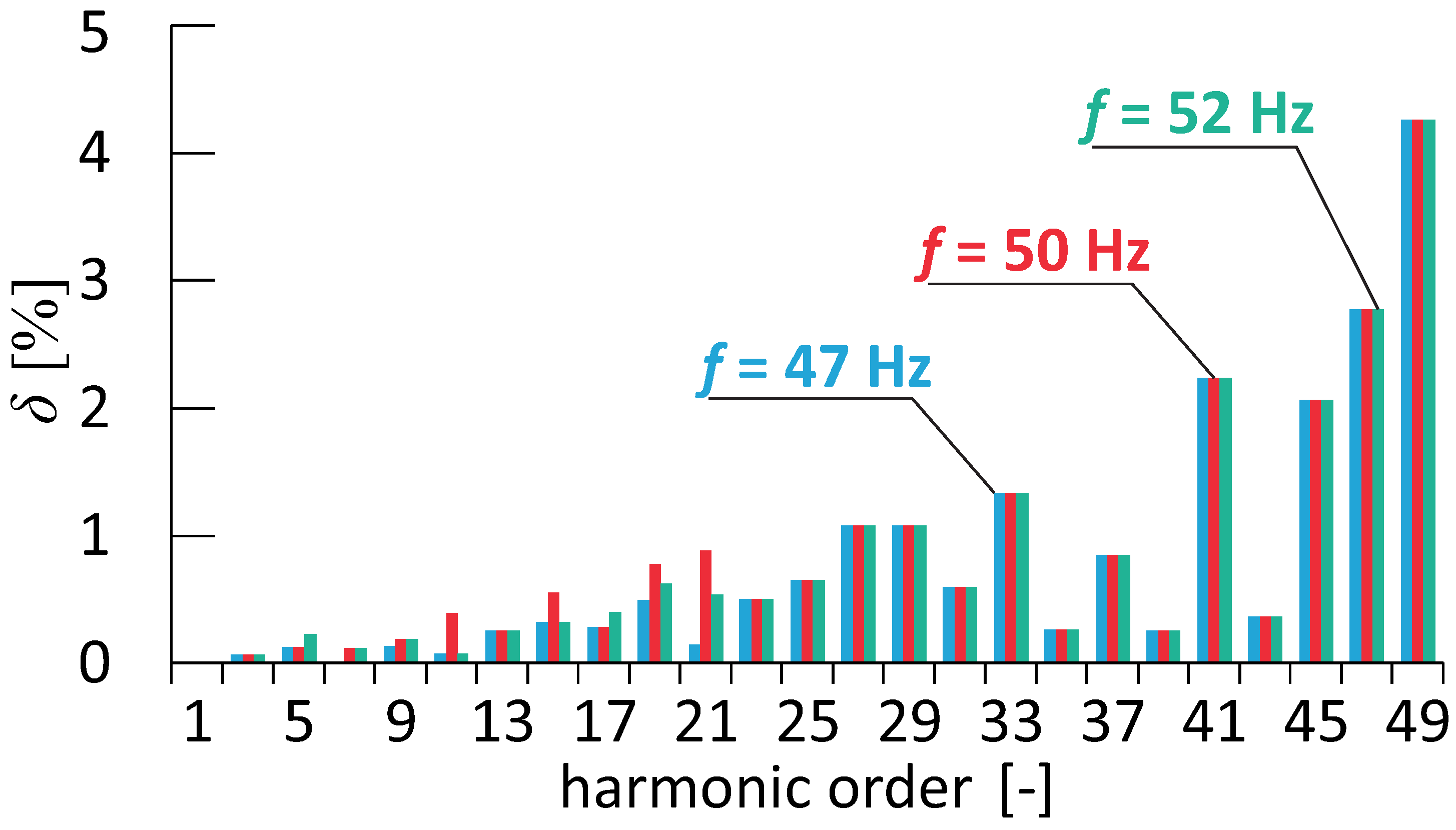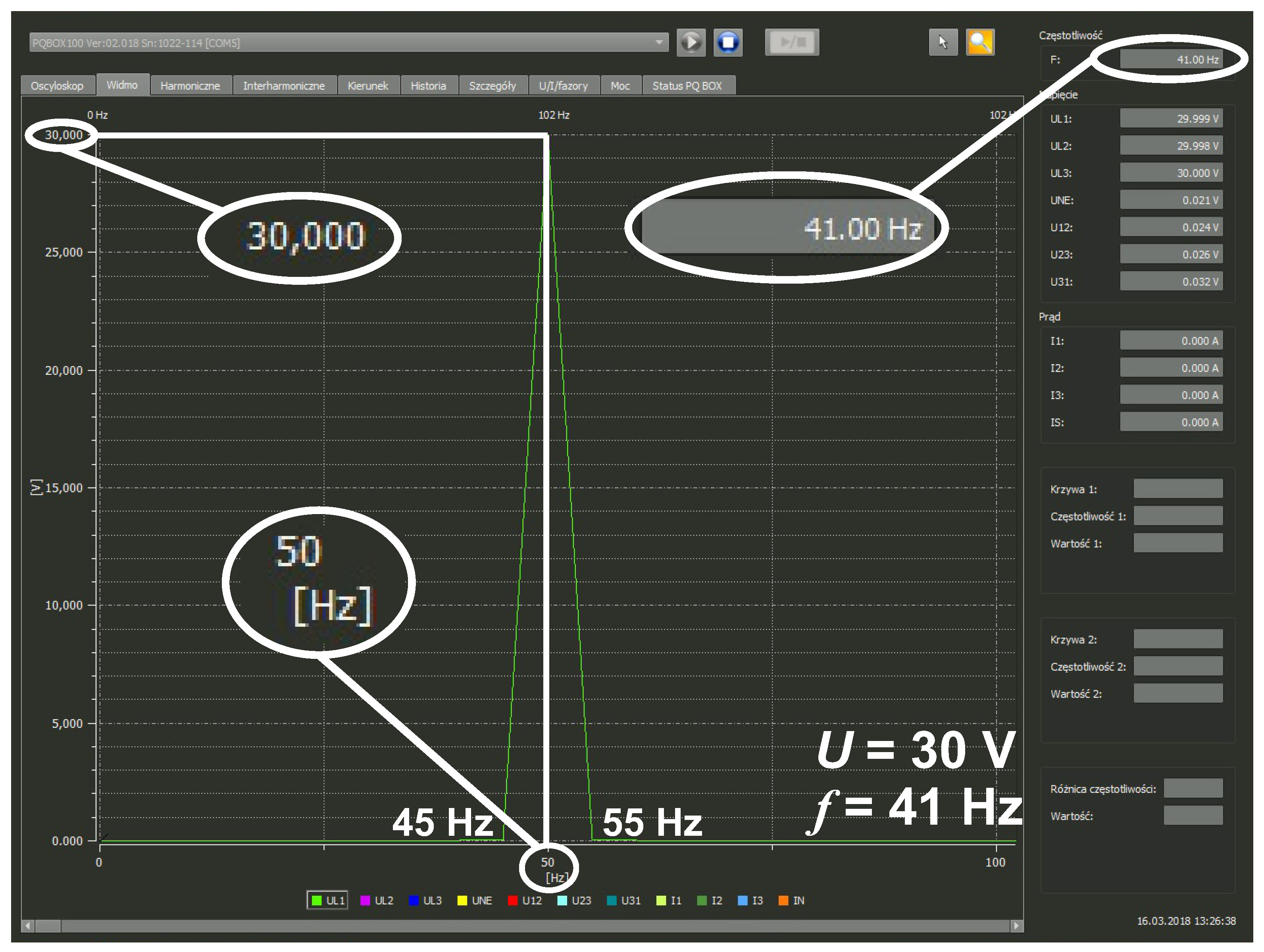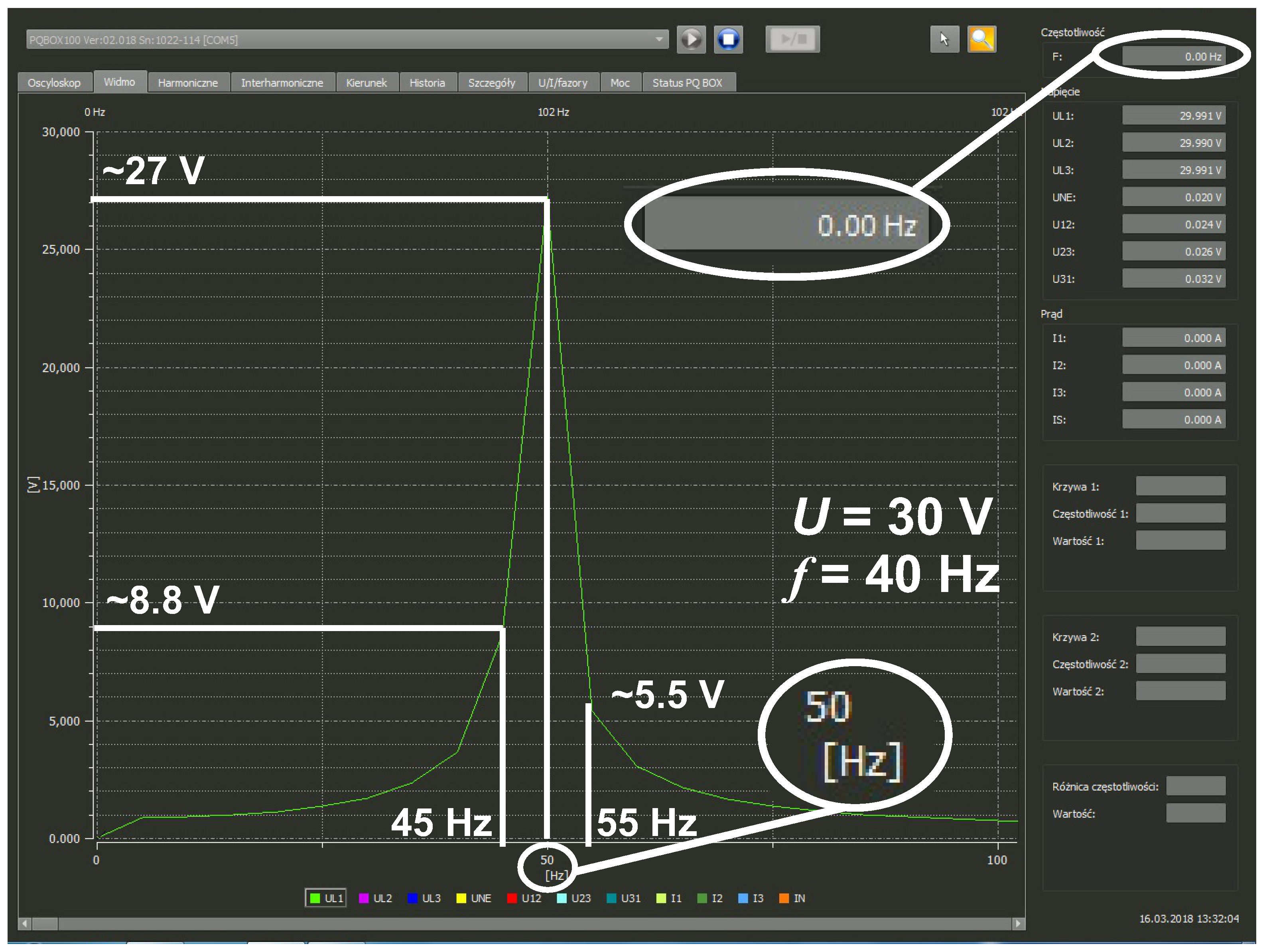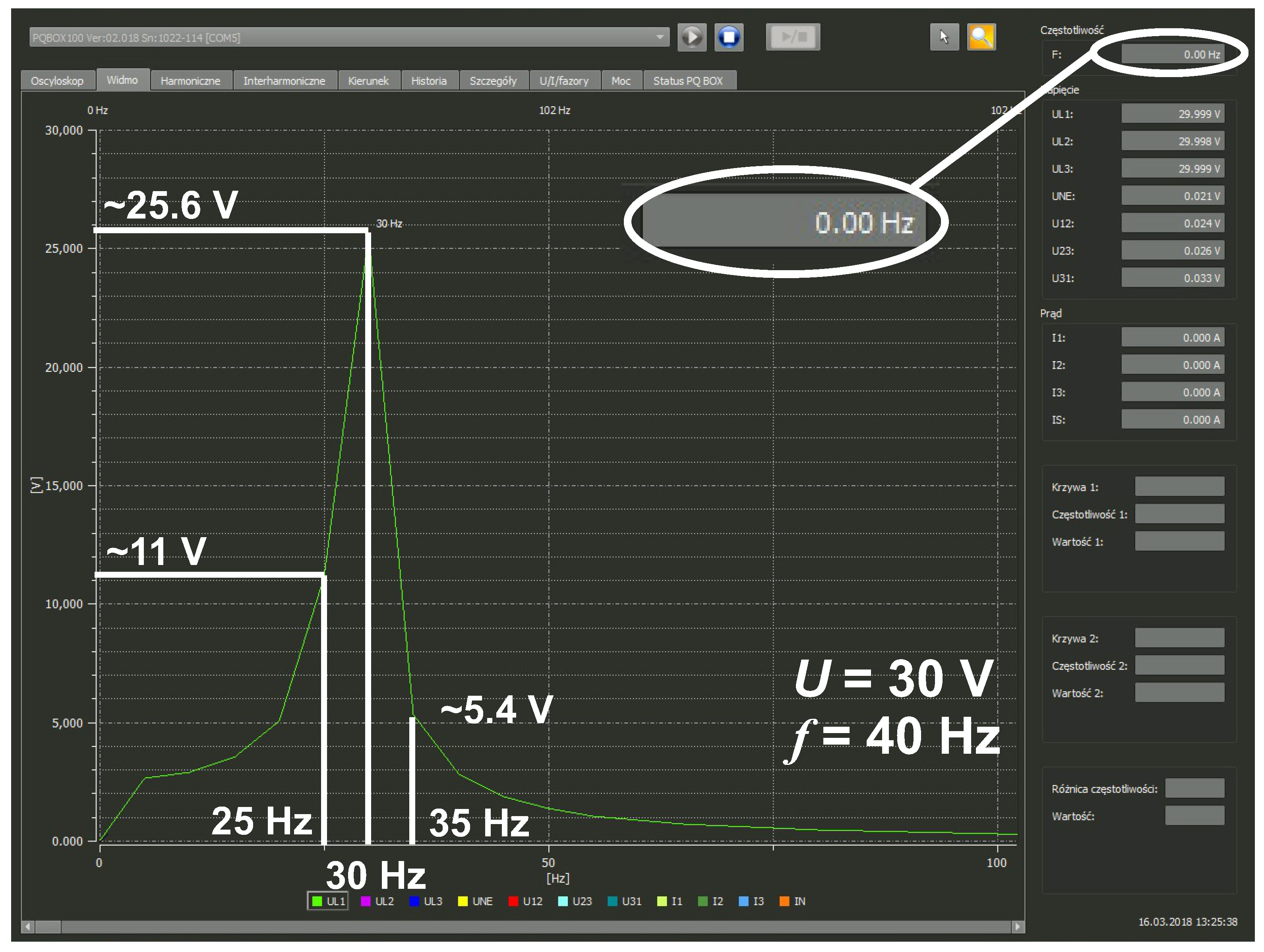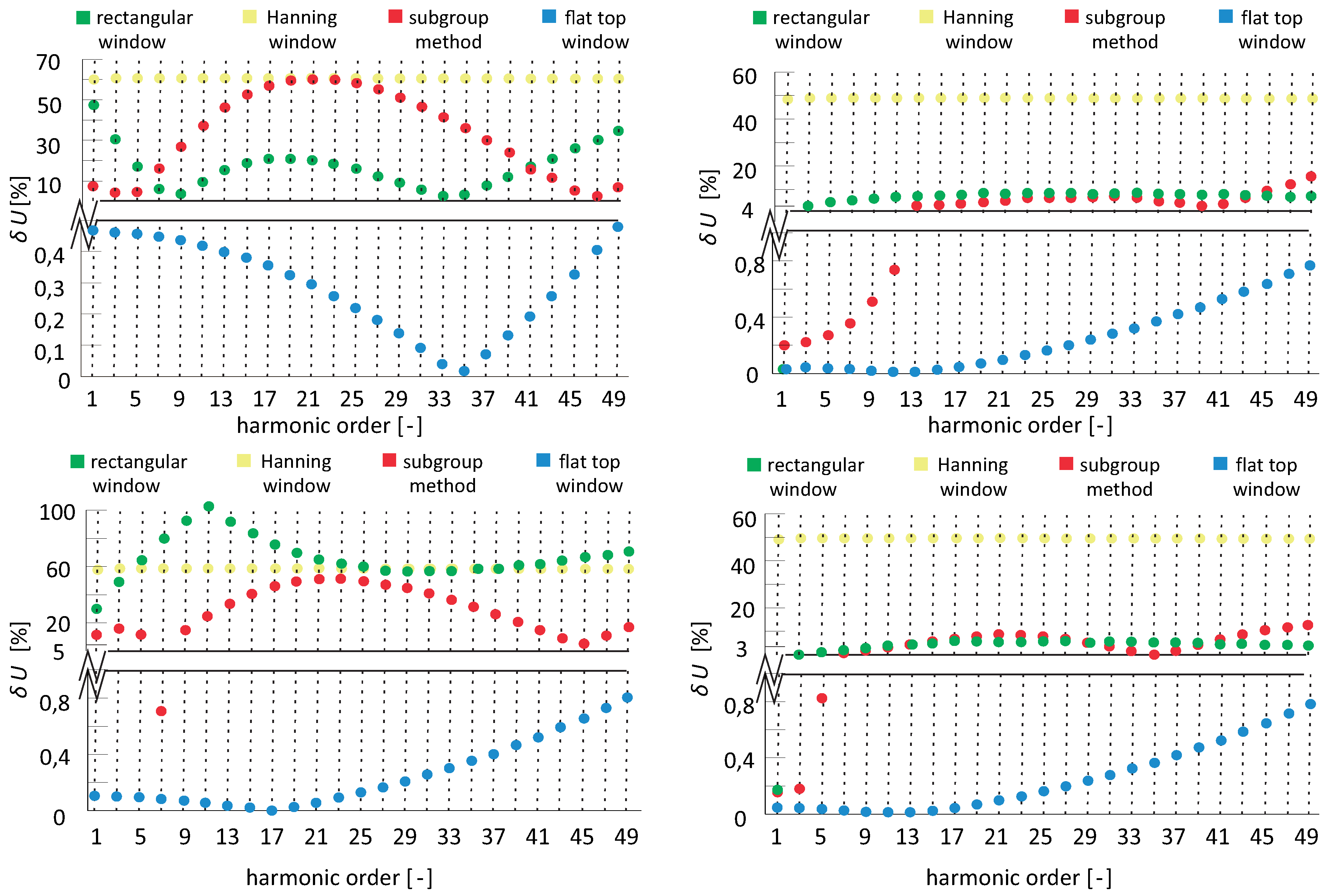1. Introduction
To assess power quality, we use a set of standard and complementary quantities contained in documents [
1,
2]. Among them, there are two measures of harmonic content: amplitude spectrum—i.e., a set of values of particular harmonics—as well as Total Harmonic Distortion (THD). The measurement of harmonic content is carried out using the Fast Fourier Transform (FFT) algorithm. This algorithm assumes the stationariness of the measured signals. Thus, the algorithm assumes that the measured voltage and current are periodic signals with a constant period
T. In the real power grid, these measured signals are non-stationary. Thus, to perform a correct FFT analysis, it is necessary to measure the harmonic content for short measurement periods in which the waveform is stationary. However, in the case of an incorrect adjustment of the measurement window (e.g., when the synchronization is lost), a spectrum leakage phenomenon occurs, which can disturb the evaluation of the tested signals. Incorrect adjustment of the measurement window is a situation in which the duration of the measurement window is not a total multiple of the fundamental period of the measured signal. These measures of harmonic content, as well as other quantities used in power quality assessment, are measured with power quality analysers. The measurement results, registered with those devices, make it possible to diagnose the state of power network—e.g., through detecting disturbing loads. The discussion of these topics can be found, among others, in scientific papers [
3,
4,
5,
6,
7,
8,
9,
10]. Taking into account the possible applications of power quality analysers, it is very important to evaluate the inaccuracy of measurement results obtained using these analysers. The problem of measurement error evaluation of harmonics content using Fourier series was described, among others, in [
11]. The measurement result is complete when it contains both the value of quantity measured and the uncertainty of measurement result connected with this value. It is assumed, according to document [
12], that the measurement uncertainty is a non-negative parameter characterising the dispersion of the quantity values, assigned to the measure and, calculated on the basis of the information obtained.
The measurement results were completed with a presentation of the uncertainty budget. The carried-out research also allowed for the metrological assessment of the effect of the spectral leakage phenomenon on the measurement of harmonic content by the class A power quality analyser. The proposed solution was compared with the methods of reducing the effects of spectrum leakage recommended by the standard [
13]. The metrological analysis of obtained measurement results allowed for the drawing of final conclusions.
The original contributions of the paper include the metrological assessment of the content of higher harmonics measurement accuracy by class A power quality analysers with the use of a proprietary measuring stand containing instruments calibrated by the Main Office of Measures. The proposed approach and the prepared measurement stand enable the testing of power quality analysers, considering the phenomenon of “spectrum leakage” and can be used for serial testing of the accuracy of harmonics measurements with different power quality analysers by the institutions associated with measurements and technical inspections.
2. Measuring System for Testing Power Quality Analyser
The paper presents a measuring system for the evaluation of metrological properties of a power quality analyser. Research on the selected PQ-Box 100 analyser was conducted on a constructed measuring system, presented in
Figure 1.
In the measuring system presented in
Figure 1, a waveform generator allows us to set a certain shape of waveform and control the operation of function calibrator. The calibrator generates a signal with a shape set from the generator, and with certain root mean square (RMS) values of voltage. The waveform generator used in measurements was calibrated in the Main Office of Measures, where its accuracy was verified.
The value of the limiting error of frequency reproduction, given in the calibration certificate, together with the uncertainty of its determination, for triangle waveform is equal to
. The function calibrator generates a voltage signal with a shape set from the generator. The value of the limiting error for the considered values of signal is equal to
, where
denotes the indicated value, and
denotes the value of measurement range. The signal generated in that way is then transmitted to the tested analyser. Because the tests are very time-consuming, only selected values were verified: the RMS of voltage and the distribution of harmonic components [
14].
Connecting an analyser with the PC computer through the USB 2.0 interface allows for the transmission of measurement data. Software attached to the analyser supports a detailed analysis of registered measurement results, their statistical processing, as well as visualisation in diagrams. One of the testing functions was periodic signal , which can be presented as a trigonometric Fourier series, according with the generally known dependencies. Representation of signal , in the expansion of function in the Fourier series, refers to an infinitely large number of components. In practice, it is impossible—and we use a finite number of components. In measurement practice of power systems, usually first dozen components are used. In the considered case, the measurements are limited to a harmonic of 50-th order. The measurements were carried out for voltages in all three phases; however, due to the repeatability of results, the results were presented only for a selected phase . In all measurements the measurement errors were determined as a difference between the measurement result and the value of reference quantity. Different testing signals were used to evaluate the difference of measurement of the RMS of voltage and harmonics content with a selected power quality analyser. The investigated power quality analysers are calibrated in two stages.
The first stage consists in calibrating the meter with a distorted signal, and with a given RMS. The other stage consists in calibrating the meter with a sinusoidal signal with the same RMS as the distorted signal. Two types of distorted waveforms were used in the tests:
Calibrating a meter with sinusoidal signal for which an expected value of harmonics content is equal to zero, aimed at testing the so-called “zero” of the analyser for a distorted function composed of a sum of two signals—basic harmonic and a selected higher harmonic. The basic harmonic value had an RMS equal to 230, and the value of higher harmonic 18.4, which is 8% of the value of basic harmonic. The RMS of such a testing signal was equal to 230.7.
Table 1 presents examples of the research results for a testing signal distorted with one harmonic component. Similarly, as in case of other input functions, because of the repeatability of results, the results presented here refer to the phase
of the analyser.
Table 2 presents a summary of measurement results of the investigated analyser for input functions with sinusoidal signals for phase
.
Table 3 summarizes the obtained exemplary results of measuring the percentage of particular odd harmonics in triangle input function. The value of distortion factor, calculated from expression (
1), is equal to THD = 12.114%. The measurements are presented for selected phase
. Measurement uncertainty of the investigated analyser, presented in the last columns of
Table 1,
Table 2 and
Table 3 was evaluated according to the uncertainty propagation law. The following factors were considered: measurement standard uncertainty of difference of measurement result and the value of reference quantity for distorted and sinusoidal signal, measurement standard uncertainty connected with the resolution of analyser for both signal and standard uncertainty connected with the limiting error of reference standard.
All the measurements were repeated many times—minimum 10 times,—in order to define the scatter of measurement results, and to eliminate possible excessive errors. In order to determine the value of measurement result uncertainty, it is necessary to correctly define the measurement equation, which should take into account all the factors influencing the final measurement result.
When the analyser is calibrated with distorted signal, with a given RMS, the equation for measurement error
takes the form given with dependence (
2):
where:
—value of the quantity measured by the investigated analyser;
—reference value for a given signal;
—value connected with the resolution of the indications of measurement device during the measurement of distorted signal;
—value connected with the limiting error of reference standard during the measurement of distorted signal.
For calibrating the analyser with sinusoidal signal, with the same RMS as for the distorted signal, the equation for measurement error
takes the form given with dependence (
3):
where:
—value of the quantity measured by the investigated analyser;
—reference value;
—value connected with the resolution of the indications of measurement device during the measurement of sinusoidal signal;
—value connected with the limiting error of reference standard during the measurement of sinusoidal signal.
The is the value connected with the resolution of the indication of measurement device. This value must be added to the value of measurement error. While the is the value connected with the limiting error of reference standard. This value is known and given by the laboratory of Main Office of Measures in the calibration certificate together with the uncertainty of its determination. Therefore, this value must be subtracted from the value of measurement error.
As mentioned before, the final record of measurement result should contain both the value of quantity measured and the measurement result of uncertainty connected with this value. Often, the measurement uncertainty contains a several components. Some components can be determined with method A for determining measurement uncertainty, consisting in the calculation of the component value of measurement uncertainty by means of statistical analysis of the measured values obtained in defined measurement conditions. Other components, whose values can be determined with method B for determining the measurement result uncertainty, could be characterised with standard deviation, determined from the probability density function based on experience or other information. A detailed description of determining uncertainty with method A or method B, can be found in document [
15]. The combined standard uncertainty of measurement
of determining the measurement error of analyser for distorted signals is given with dependence (
4):
where:
—denote sensitivity coefficients;
—denotes value connected with the limiting error of reference standard, which is determined as a geometric sum of values and .
The values of sensitivity coefficients were determined as the partial derivatives of measurement function
in regard to particular variables given with Equation (
4). After carrying out the calculations, we got an expression for the value of combined uncertainty
:
When estimating the measurement uncertainty of investigated analyser, the following factors should be taken into account:
Measurement standard uncertainty of difference in measurement result and the value of reference quantity for distorted signal ;
Measurement standard uncertainty connected with the resolution of analyser indications during distorted signal measurement ;
Measurement standard uncertainty of difference in measurement result and the value of reference quantity for sinusoidal signal
. Because the expected value
is equal to zero, randomization is done on a random variable
with measurement uncertainty
. Measurement standard uncertainty, with normal distribution assumed, according to the uncertainty propagation law, is given with Equation (
6):
Uncertainty determined in that way is associated with the instability of indications of the investigated analyser for sinusoidal signal. Combined standard uncertainty of measuring
distorted signal is expressed with dependence (
7):
Measurement standard uncertainty connected with the resolution of analyser indications during the measurement of sinusoidal signal ;
Standard uncertainty connected with the limiting error of reference standard .
Standard uncertainties associated with the resolution of analyser indications, with rectangular distribution assumed, can be determined from Formula (
8):
where
defines the resolution of investigated analyser.
All the components of expanded uncertainty listed above were determined and included in the final uncertainty budget. The expanded uncertainty of measurement result was determined according to recommendations contained in document [
16]. Its value was determined based on the uncertainty propagation law, and the analysis took into account the scatter of measurement results, resolution of investigated analyser, as well as inaccuracy of calibrator and the waveform generator. The given uncertainty values constitute the expanded uncertainty with assumed confidence level equal to ≈95% and coverage factor
k = 2. The developed uncertainty budget takes into account all identified component uncertainties estimated with methods A and B, and also those with values estimated as zero. Such information means that a given component of uncertainty was analysed, and assuming its zero value is justified with measurement conditions [
17].
Table 4 presents an example of uncertainty budget for a waveform composed of a sum of two signals: basic harmonic and selected higher harmonic. When all the components were taken in the uncertainty budget, it was possible to determine which component uncertainties had the biggest participation in combined uncertainty—i.e., to indicate directions for improving the measurement, which would lead to a considerable decrease in combined uncertainty. In order to assure measurement traceability, the calibration results were referred to reference standards of the Main Office of Measures (GUM):
Units of measure of electric voltage by using calibrators;
National standard of units of time and frequency measures, maintained in GUM using a frequency generator.
3. The Phenomenon of Spectrum Leakage
According to the standard [
13], the discrete Fourier transformation (DFT) is applied to analyse the harmonics. This is a Fourier transformation changing a signal into the form of a sequence of samples from the domain of time into the domain of frequency. However, the implementation of the DFT algorithm is not sufficiently fast. Therefore, an algorithm of fast Fourier transformation (FFT) is commonly applied. In order to carry out a full Fourier analysis using the DFT or FFT algorithm, an infinite number of samples of measured signals is necessary. Then, it is possible to find the whole spectrum of the considered signal. However, the observation is finite, so the number of samples is also finite. This fact results in the analysis of a finite value of the frequency of the considered signal. According to the recommendations of standard [
2], the frequency analysis of voltage is carried out for the first 40 harmonics. Thus, a finite number of samples is sufficient. The process of signal sampling is controlled by the signal acquisition block together with an A/D converter. Theoretically, it is a product of the examined function and a comb function, which is a Dirac delta function. The process of selecting a finite number of samples is controlled by time windows. The notion of time window should be understood as function
w(
n) that describes the method of taking signal samples with a finite interval of values different from zero. Assuming that a certain signal
u(
n) is observed, a result of the observation, using a time window, is a signal
g(
n) given with Equation (
9):
Spectrum leakage phenomenon is strictly related to the time window—i.e., to the window in which the measurement is done. It occurs when the duration of the measuring window is not a total multiplicity of the period of the considered signal. Further, part of the paper presents the influence of applied measuring window onto the spectrum leakage phenomenon. The measurements were carried out in a designed and constructed measuring system, shown in
Figure 1. A simplest measuring window—i.e., a rectangular window, was considered; it is applied in a majority of power quality analysers, and it is recommended by the standard [
13]. Rectangular window is given with Equation (
10):
where
N denotes a finite number of samples.
The spectrum of function
w(
n) presented above is an interpolation function sinc(
t)—sinus cardinalis—defined by Equation (
11):
The function given by the Equation (
11) is a Fourier transform of the rectangular function (
10).
The transform of the product of two functions in the domain of time is a convolution of those functions in the domain of frequency. The effect of such operation is that side lobes occur in the considered signal. When the duration of measuring window is not a total multiple of the period of the primary signal considered, as a result of the occurrence of the side lobes of the considered signal, the spectral lines will be extended. This effect is named spectrum leakage phenomenon. In order to illustrate the spectrum leakage phenomenon, we are going to consider a sinusoidal signal. The result of discrete Fourier transformation can be identified with the sampling of continuous convolution of the considered signal spectrum and the measuring window. The sinusoidal signal spectrum with a frequency of
is composed of two spectral lines in values
. The convolution spectra of sinusoidal and rectangular signals with duration equal to the total multiple of the period of considered signal are presented in
Figure 2. In such a case, a non-zero sample of the convolution spectrum for a frequency is equal to the fundamental frequency of the signal. The remaining samples will be taken in the zeros of the sinc(
t) function. When the window is not an total multiple of the examined signal period, the spectrum convolution samples will be taken in different values of the sinc(
t) function, which is presented in
Figure 3. In the situation shown in
Figure 3, the phenomenon defined as spectrum leakage occurs; its consequence is a strong disturbance at the window edge, and in practice the spectrum leakage causes changes in values and displacements of higher harmonics. Moreover, spectral lines, being subharmonics and interharmonics, can appear.
In order to minimalize this effect, it is possible to apply measuring windows different than rectangular, which will ensure signal suppression at the window edge. The problem of determining the values of harmonics and related errors, for different values of frequency
f, is a complex measurement task. The raised issues are discussed in a number of publications [
18,
19,
20,
21,
22,
23]. In the publications [
24,
25,
26,
27,
28,
29] the authors describe methods for improving the FFT algorithm when thefrequency changes, with the use of the developed algorithms, while in the publications [
30,
31,
32] the authors present their own approach to solving the problem—i.e., they propose to use a “Flat Top” window in FFT analysis instead of using a basic rectangular window. The publications [
33,
34] present a method for analysing harmonics for selected time windows, with the use of Matlab.
5. Experimental Research on Influence of the Spectrum Leakage
During the experiments, higher harmonics of voltage were measured, including the spectrum leakage in the range of acceptable power frequency changes. A three-phase class A analyser PQ-Box 100 was subjected to research in a designed and constructed measuring system presented in
Figure 1. Higher harmonics were measured for triangle testing signal described with Equation (
1). The research was carried out for the following frequency values of the considered signal: (47 and 52)
—extreme acceptable frequency voltage values in a power grid per annum—and (49.9 and 50.1)
—extreme values of voltage frequency deviation in practice, presented in
Figure 5.
According to the presented description of spectrum leakage phenomenon, the effect will occur when the measuring window is not matched to the period of the considered signal. According to [
13], it is recommended to use a measuring window equal to 200
. In such a case, the negative phenomenon will not occur. However, the power frequency is not constant. The measurements carried out aim at determining the influence of spectrum leakage regarding the changes in voltage frequency of the power grid which the service provider allows over the year. To describe the problem of spectrum leakage, in the process of power quality evaluation, errors were determined in relation to individual measure and total measure, characterizing higher harmonics. In the case of individual measure, a relative error given by Equation (
14) was used:
where:
is the RMS of particular harmonics determined by the analyser, and
is the RMS determined from the expansion of the function into a trigonometric Fourier series. In the case of total measure, a relative error given by Equation (
15) was used:
where:
is the value of THD factor determined by the analyser, and
is the value of THD factor determined on the basis of the expansion of the function into a trigonometric Fourier series.
The measurement results obtained for the higher harmonics of this function were very similar (with an accuracy of device resolution), regardless of signal frequency changes in the range of 47 to 52 . Therefore, in the present paper only the measurement results for the frequencies of 47, 50 and 52 are included.
Based on the determined error values, the characteristics of
were presented in a diagram, depending on the frequency of the considered signal, in
Figure 6 and
Figure 7, respectively.
Based on the measurement results, it is possible to formulate a conclusion that the considered analyser PQ-Box 100 during the measuring of higher harmonics is indifferent to the frequency variations of considered signal in the given range. However, when applying even the algorithm given in standard [
13], the effects of spectrum leakage should be noticeable. It is the subject of simulation research described in the next chapter of the paper. On this basis, we can conclude that the measuring device has an additional algorithm implemented, which makes it possible to avoid the effects of an unmatched measuring window.
In order to confirm the above argument, additional research was carried out. The frequency of the considered signal was decreased by 1
, until the effect of spectrum leakage was visible. For this purpose, an online measurement was applied with the use of a PC. Online measurement is the analyser measurement mode, allowing us to view the measured parameters in the real time. In this mode, it is possible to perform a detailed analysis of many parameters measured by the power quality analyser, which are not registered in offline mode and are not saved in the memory of the measuring and recording device. The noted threshold value of the frequency was 41
. Up to this value, inclusive, the spectrum of the considered signal was unchanged. In contrast, when the signal frequency amounted to 40
, the analyser did not measure the frequency correctly, and the effect of spectrum leakage became visible. The described situation was repeated when the frequency of the considered signal was increased. The upper limit was the frequency value equal to 70
. It can be concluded that the algorithm eliminating the effect of not matched window is directly related to the measurement of signal frequency by the analyser. During the online research, the sinusoidal signal spectrum observed on a PC, with a frequency change in a range of 41 to 70
, was always composed of one spectral line for frequency
f equal to 50
. An example of screen for the given situation is presented in
Figure 8, where a single spectral line is visible for
f = 50
, although the considered signal is a sinusoidal signal with the frequency equal to 41
and the RMS equal to 30
.
When the above mentioned threshold value 41
or 70
is exceeded, the analyser does not detect the frequency of the considered signal, and the effect of spectrum leakage is visible in the spectrum observed online. A few such cases occurred randomly as a result of research repeated many times. The highest spectral line occurred at the frequency of
f = 50
for signal frequency equal to 40
or 71
, at the frequency of
f = 30
for signal frequency equal to 40
, or at the frequency of
f = 85
for signal frequency equal to 71
. It must be pointed out, however, that, in real power grids, substantial deviations from the nominal frequency value do not occur.
Figure 9 and
Figure 10 present examples of two cases of such measurements.
Reassuming, it must be concluded that, during the measurement of higher harmonics, the considered analyser is indifferent to the spectrum leakage phenomenon in the range of acceptable frequency changes per annum. Moreover, the research indicates that there is an algorithm, implemented in the device, correcting the effect of the unmatched window on the measurement result. Despite some attempts to obtain information about the applied software from the manufacturer of the device, the manufacturer has not made available the detailed data, invoking trade secret.
6. Simulation Research on Influence of the Spectrum Leakage
For the purpose of present paper, simulations were carried out for the triangle signal, which was used in the measurement part, for the same frequency values. In order to evaluate the quality of eliminating the spectrum leakage, the time windows described in the paper were selected—the Hanning window and the flat top window. In practice, according to the standard [
13], the effects of spectrum leakage are minimised through subgrouping the harmonics of the
h-th order, according to Equation (
16):
where:
is RMS of the
h-th subgroup, and
is the RMS of
k-th DFT result.
Therefore, the solutions proposed by the authors are compared with the subgroup method. The methods were compared using a simulation software developed in the Matlab environment.
Figure 11 presents the simulation results depicting the value of error
in the function of odd harmonics, for the considered values of frequency
f. Because of significant differences in the values of error
for particular windows, the vertical axis was divided, as if “dissected” in the diagrams, for better visualisation of the differences.
Analysing the results obtained for the triangle signal, we can conclude that due to the fact that successive harmonics decrease in inverse proportion to the order square, the measurement error of higher harmonics takes significant values and is many times bigger than for other functions analysed by the authors. Based on the obtained simulation results, it is possible to formulate a conclusion that, because of its properties, the flat top window eliminates the negative effects of spectrum leakage in the best way among all the discussed methods. The other proposed windows, because of low accuracy regarding typical frequency changes, are useless in practical applications from the point of view of power quality evaluation.
